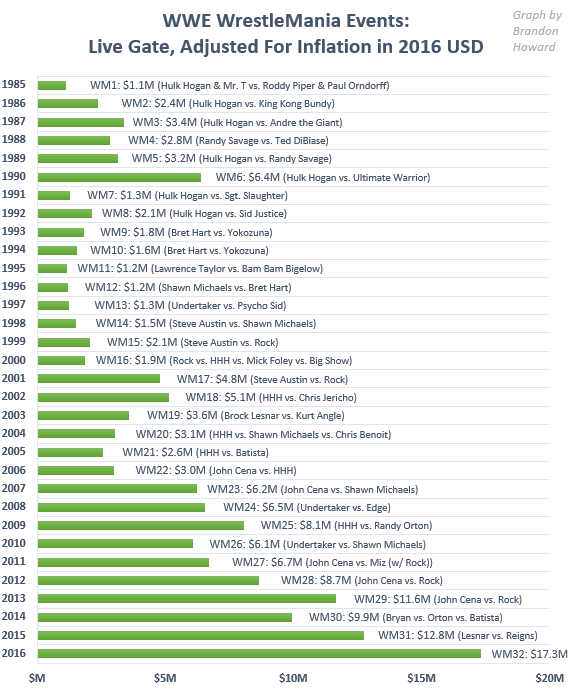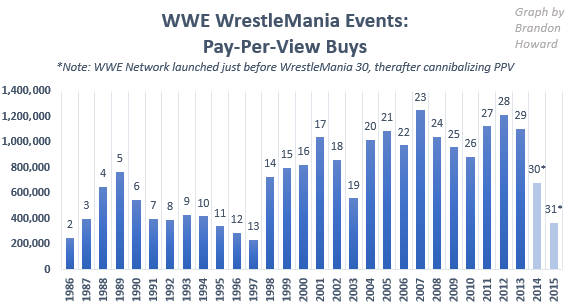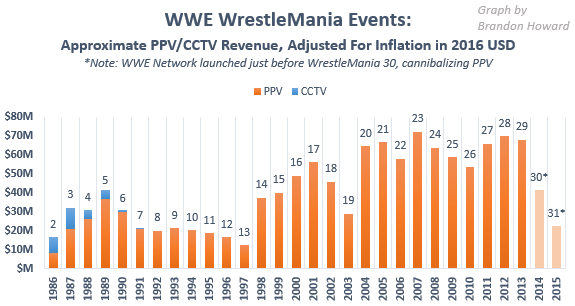WrestleMania Business Stats: Which Mania Was the Biggest?
Measuring the success of WrestleMania has evolved over the years as WWE exploited emerging forms of media to drive business to the biggest pro wrestling show of the year.
Pay-per-view was so new in 1985 that there isn’t much data out there to tell us how many buys the inaugural WrestleMania received. Some recall that the PPV price for the show was just $9.95 (although the price point may have varied among providers). The first WrestleMania, main evented by Hulk Hogan teaming with Mr. T to take on Roddy Piper and Paul Orndorff drew $3.8 million (or more like $8.5 million when adjusting for inflation) on closed circuit television, the precursor to pay-per-view, as fans attended venues and theaters throughout at least the U.S. to watch the event live from the sold out Madison Square Garden in New York City.
Since that first WrestleMania, and massive gamble by Vince McMahon, pay-per-view grew into a huge business for WWE, peaking at 1,250,000 million buys and $62 million in revenue (before splitting with PPV providers) for WrestleMania 23 in 2007. In 2014 WWE made the bold choice to forego PPV and launch its own Netflix-like over-the-top service, the WWE Network, which for the purposes of this article somewhat obfuscates comparisons we might make between post-2014 WrestleManias and the rest that came before.
Live Gate

Live event revenue however is the one stream that’s remained constant throughout WrestleMania history. When we look over the 32 years of WrestleMania events so far, we can see the brand’s rise from being the epicenter of the company’s initial mainstream boom, its decline along with the then-WWF’s overall finances in the mid-90s, and the resurgence during the boom of the late 90s. Even after WWE’s popularity wore off in the 2000s however WrestleMania has become more lucrative than at any point in company history. Since 2007 the show has been held at a stadium each year, and with that and ever-increasing ticket prices, the live gate has increased from the previous year more often than not.
Meanwhile WrestleMania has turned into an annual tourist event for traveling wrestling fans from all over the world, with a new destination city each year. The peak event has become more peak, both in WWE’s creative process — with so much importance placed on what matches will happen at WrestleMania and what major stars of the past will return for big matches — as well as the company’s financial picture.
It’s to WWE’s credit, and the legacy its cultivated — the legend surrounding WrestleMania — that the company’s been able to make its biggest show of the year so big that the live gate roughly doubles that of WWE’s most popular era, even while popularity of the product overall has been middling for most of this century. This phenomenon supports the notion that in the last ten years or so, wrestling fandom has become increasingly niche: the biggest shows are bigger than ever, attracting more and more traveling fans; ticket prices keep increasing; passionate fans whose teen years passed through the mythical Attitude Era are now fully grown and employed adults with disposable income, and they spend more and more of it on wrestling each year.
WrestleMania 33 has the highest ticket prices ever for a WWE event — and probably the highest for any wrestling event ever, with retail prices ranging from $160 to $3,000. Even though attendance in Orlando for this year’s show will likely be lower than that of WrestleMania 32 in a larger venue, I predicted last month that this year’s show could break last year’s all-time pro wrestling record gate of $17.3 million, maybe drawing as much as $18 million in ticket sales.
Pay-Per-View Buys
WrestleMania was once one of the biggest pay-per-view events each year of any kind. Of course since the launch of the WWE Network in February 2014, most of those purchases have been cannibalized. Since 2014, it’s more difficult to extract just how much money WrestleMania generates as it’s virtually impossible to predict what Network subscriptions and financial figures would be if viewing access to WrestleMania wasn’t included on the Network.
In the pre-Network world however WrestleMania 23 was and is the record-holder for most PPV buys ever for a WWE event with 1,250,000 buys. That was for the event headlined by Donald Trump and Vince McMahon each putting their hair on the line in a match where they were represented by Bobby Lashley and Umaga, respectively; major title matches on that show were John Cena vs. Shawn Michaels and Undertaker vs. Batista.
The next three most-bought WrestleManias on PPV featured The Rock (Dwayne Johnson) in his return to WWE, after becoming a major film star, for WrestleManias 27, 28 and 29. Rock’s first match against Cena at WrestleMania 28 drew 1,217,000 buys, almost equaling the Trump-headlined event in 2007. (Insert joke about the popular vote here.)

Pay-Per-View Revenue
The PPV price point for WrestleMania has changed throughout the years, so PPV revenue and buys are strongly correlated but a study of PPV revenue produces slightly different rankings.
With assistance from some folks on Twitter, the following are PPV price points we dug up for each WrestleMania. Keep in mind these prices are the suggested retail price, and price for particular providers may have varied. In many cases in the 80s and 90s, the price was lower if you purchased the PPV early and more expensive if you purchased on the day of the event. For example if you purchased WrestleMania 3 at least two weeks in advance, you paid $19.95; 13 to 2 days before the event and it was $24.95; and day-of-event purchases were $29.95. And there are other quirks like the one-off “All Day WrestleMania” offering for $49.95 which featured several hours of previous years’ WrestleMania footage in the lead up to the live event later that day, which customers could have purchased alone for just $34.95.
| Mania # | Year | PPV price |
| 1 | 1985 | $9.95? |
| 2 | 1986 | $12.95 – $15.00 |
| 3 | 1987 | $19.95 – $29.95 |
| 4 | 1988 | $24.95 |
| 5 | 1989 | $29.95 |
| 6 | 1990 | $29.95 |
| 7 | 1991 | $29.95 |
| 8 | 1992 | $29.95 |
| 9 | 1993 | $29.95 |
| 10 | 1994 | $29.95 |
| 11 | 1995 | $34.95 |
| 12 | 1996 | $29.95 |
| 13 | 1997 | $29.95 |
| 14 | 1998 | $34.95 |
| 15 | 1999 | $34.95 |
| 16 | 2000 | $34.95 (“All Day” $49.95) |
| 17 | 2001 | $39.95 |
| 18 | 2002 | $39.95 |
| 19 | 2003 | $39.95 |
| 20 | 2004 | $49.95 |
| 21 | 2005 | $49.95 |
| 22 | 2006 | $49.95 |
| 23 | 2007 | $49.95 |
| 24 | 2008 | $54.95 SD / $64.95 HD |
| 25 | 2009 | $54.95 SD / $64.95 HD |
| 26 | 2010 | $54.95 SD / $64.95 HD |
| 27 | 2011 | $54.95 SD / $64.95 HD |
| 28 | 2012 | $54.95 SD / $64.95 HD |
| 29 | 2013 | $59.95 SD / $69.95 HD |
| 30 | 2014 | $59.95 SD / $69.95 HD |
| 31 | 2015 | $59.95 SD / $69.95 HD |
| 32 | 2016 | $59.95 SD / $69.95 HD |
| 33 | 2017 | $59.95 SD / $69.95 HD |
Again many of the prices listed above may increased (usually by $5.00) for same-day purchases.
The price point mostly increased over the years, but WrestleMania 12 in 1996 was actually offered for $29.95 after the price was increased in 1995 to $34.95 for the event featuring former NFL star Lawrence Taylor.
I added in closed circuit TV revenue to the graph below since CCTV was a major avenue for consuming WrestleMania in the early years while PPV capabilities were still developing. Like with live gate revenues, these dollar figures have been adjusted for inflation.

WrestleManias 23 (2007) and 28 (2012) are still the top two draws from this perspective. Mania 27 (Cena vs. Miz with Rock ringside) was no. 3 for buys but no. 5 for inflation-adjusted PPV revenue. Mania 29 (Cena vs. Rock rematch) jumps up here to no. 3 thanks to a higher price point. And WrestleMania 21, headlined by Triple H vs. Batista, is up to no. 4 thanks to the adjustment for inflation.
Another big change is that when you factor in CCTV money, WrestleMania 3 (featuring Hulk Hogan vs. Andre the Giant) is ahead of WrestleMania 4 (the WWF Title Tournament show).
WWE has been more popular at different periods in its history: clearly during the Hulkamania era of 1986-1989 and the Attitude Era from 1998-2001. Popularity of the WWE product overall in the last 15 years has been stable but not near the levels of those two boom periods. WrestleMania itself however is more popular than ever. WrestleMania as a live ticket and a PPV or SVOD event is more valuable in this era than ever. That’s before factoring in residual increases in revenue WWE receives from the rising number of events it runs on WrestleMania weekend as this phenomenon has unfurled: the Hall of Fame ceremony, NXT Takeover, RAW the next night, SmackDown the night after that, Axxess events.
Plus fans spend big on merchandise during the weekend; WWE sold roughly $4 million worth of merchandise last year during WrestleMania weekend. Not to mention there’s ever-growing number of non-WWE events that benefit from running events that weekend around the hosting city.
With WrestleMania, WWE is cashing in on the children it appealed to in the 80s and 90s, when wrestling was at the heights of its popularity, who are now adults with their own independent money to spend, who are willing to go to shows not just when the circus comes to town, but who are willing to travel from across the globe to the yearly super event’s mix of modern stars and nostalgia.
Some of the data referenced here was sourced from prowrestlinghistory.com.
You can follow Brandon on Twitter at @adecorativedrop. He can be contacted by email at [email protected].




